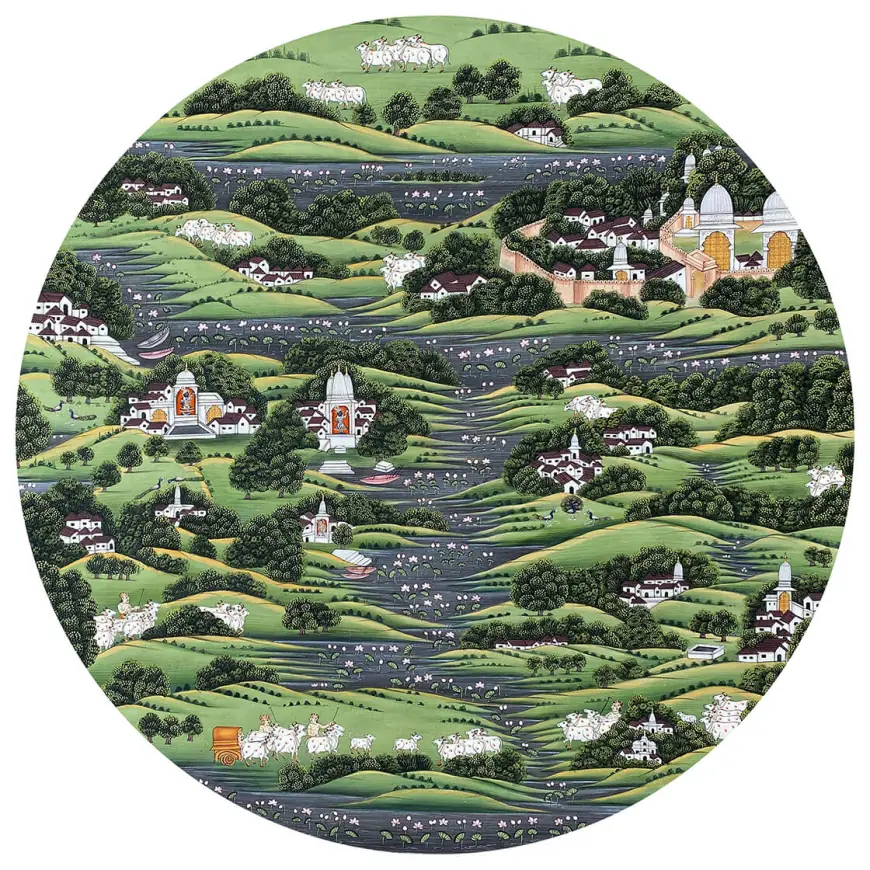Tracing the Roots of Pichwai Painting History
The story of Pichwai Painting History is more than just an artistic tradition; it is devotion painted on cloth. Originating about 400 years ago in Nathdwara, these vibrant backdrops for Lord Shrinathji’s idol gradually evolved into intricate storytelling canvases. Each painting, whether filled with cows, lotuses, peacocks, or scenes from Krishna’s life, carries a spiritual essence. The detailing is breathtaking — tiny brush strokes once made with natural colors from stones, flowers, and even gold. Though the tradition faced decline in modern times, efforts like Pichwai Tradition Pooja Singhal have revived it, blending heritage with contemporary relevance. Today, Pichwais bring calmness, beauty, and devotion into homes and galleries worldwide, standing as timeless symbols of India’s cultural pride.

Tracing the Journey of Pichwai Painting History — From Temples to Today
If you’ve ever walked inside a temple in Rajasthan, chances are you’ve come across those large, colorful cloth paintings hanging behind the idol. They are called Pichwai. And once you know the story behind them, it’s impossible not to admire the art even more. The story of Pichwai Painting History is not just about colors and designs, but about devotion, culture, and survival of an old tradition in a modern world.
How It All Started
So, where does it begin? Nathdwara — a small town in Rajasthan. That’s where Lord Shrinathji’s temple stands, and that’s where this whole tradition grew. Pichwai Painting History goes back about 400 years. The word itself comes from “pichh” meaning back and “wai” meaning hanging. Simple idea — a backdrop for the idol. But over time, the paintings became more than decoration. They became storytelling tools. Every season, every festival had its own Pichwai. Cows, lotuses, peacocks, gopis, the Yamuna river — everything connected to Krishna’s life found space on that cloth.
The Charm of the Details
One thing that hits you when you look closely is the detailing. Honestly, it’s hard to believe someone paints those tiny patterns with a brush. Pichwai Painting History shows us how patient and skilled the artists were (and still are). Earlier, they used natural colors — ground stones, flowers, even gold. Imagine the time it must have taken. Days, weeks, sometimes months on a single piece. And it wasn’t about money. It was seva — devotion. Every stroke felt like prayer.
Survival and Change
But let’s be real. Old traditions struggle in modern times. For a while, the art almost faded. Fewer buyers, fewer young artists wanting to spend months on one painting. But luckily, some people decided it was worth saving. That’s where names like Pichwai Tradition Pooja Singhal come in. Through efforts like these, the art didn’t just survive, it found new life. Now you see Pichwais in homes, galleries, hotels — even in modern décor. The themes are traditional, but formats and materials are evolving.
Why It Still Feels Special
So why do people still connect with it? Maybe because it’s not just art for decoration. It carries a spiritual calmness. Even if you’re not religious, the lotus patterns, the cows, the serene Krishna faces — they give a sense of peace. And that’s what makes Pichwai Painting History different from many other art forms. It’s alive, breathing, telling stories that are centuries old but still fresh.
Closing Thoughts
At the end of the day, the journey of Pichwai Painting History is inspiring. From temple walls to global collections, it shows how devotion can turn into heritage. And how heritage, with the right care, can stay relevant forever. The paintings may have started as simple backdrops, but today, they are symbols of India’s cultural pride.
What's Your Reaction?
 Like
0
Like
0
 Dislike
0
Dislike
0
 Love
0
Love
0
 Funny
0
Funny
0
 Angry
0
Angry
0
 Sad
0
Sad
0
 Wow
0
Wow
0

















































